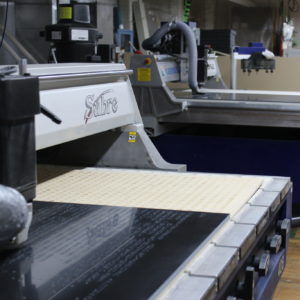 CNC machines control a range of automated machine tooling processes, like CNC knife cutting or CNC routing, that manufacturers use to produce parts and components. In fact, CNC machining is the most popular method used in subtractive manufacturing processes—those applications that cut, remove or shape the material to produce products. However, like any tool or type of equipment, common issues and problems related to CNC machine performance can delay production. There are several CNC machine tooling processes, and knowing what to look for when problems arise will help ensure uninterrupted production and unnecessary delays.
CNC machines control a range of automated machine tooling processes, like CNC knife cutting or CNC routing, that manufacturers use to produce parts and components. In fact, CNC machining is the most popular method used in subtractive manufacturing processes—those applications that cut, remove or shape the material to produce products. However, like any tool or type of equipment, common issues and problems related to CNC machine performance can delay production. There are several CNC machine tooling processes, and knowing what to look for when problems arise will help ensure uninterrupted production and unnecessary delays.
The term CNC is short for ‘Computer Numerical Control.’ The advantages to manufacturers are numerous. Above all, CNC machines offer programmable computerized control of machine tools that can produce intricate custom designs of parts and do so at exceptionally tight tolerances, precision, repeatability, and output.
A number of subtractive manufacturing techniques can be performed with CNC machinery. The most commonly used CNC machine tooling processes are cutting, drilling, milling, lathing, and routing. CNC cutting machines execute a number of advanced cutting processes. Digital machines fitted with a drag and oscillating knife can perform creasing and routing to meet large volume production needs or product development and prototyping. Those fitted with optical registration markers can even cut printed parts. Laser and plasma cutters can perform intricate cuts with very tight tolerances. Such versatility in cutting systems allows for a considerable range in the production of custom-designed parts and components.
CNC drilling can perform several drilling operations on workpieces as programmed, such as reaming, tapping, counterboring, and countersinking. Multi-point drill bits can produce vertically aligned holes and angular drilling using specialized machine configurations and placement devices. CNC milling is a tooling application with capabilities like face milling, the process of performing shallow cuts onto flat surfaces and flat-bottomed cavities, and peripheral milling—deep cavity cuts like slots and threads.
CNC lathe machines apply single-point cutting tools to remove material in a linear motion along the surface of a rotating workpiece, removing material from around the circumference. Boring, facing, grooving, and thread cutting are typical lathe cutting capabilities. Finally, CNC routers offer a number of versatile routing capabilities that can perform such tasks as 2D and 3D routing, milling, drilling, engraving, cutting.
Nevertheless, as advanced and effective as CNC machine tooling processes are, they are still machines. As with any machine or tool, they can occasionally develop issues that affect performance and quality. Unlike other machines, operators should look to any of the following three common root issues for a solution when general problems do arise.
Maintenance Issues
For CNC machines to operate at peak efficiency, regular maintenance should be scheduled to prevent any issues that could arise and interfere with operation. CNC machines are capable of performing an enormous amount of output utilizing diverse materials. Over time, however, a substantial amount of dirt, debris, and material residue accumulate. If the machines are not cleaned and lubricated regularly, they will underperform, greatly affecting the machine’s output. This will lead to a loss of precision and accuracy in manufacturing processes. Accumulation of dirt and residue in machine parts also hampers air circulation, which could lead to overheating and damage to the machine, which in turn means costly repairs, downtime, and delays. Preventive maintenance is the obvious solution.
Monitoring the Machine and Settings
Another common oversight that may negatively affect CNC machine performance relates to monitoring the machine settings and components. A telltale sign of a machine’s underperformance is the appearance of small burrs and burn marks on the edges and corners of the material. A combination of factors could be at play. Blunt or damaged tools, or tools working at the wrong speed, or a combination of both, can cause abrasive edges or leave burn marks on the material. Because each material has its own set of properties, the CNC machine settings need to be monitored and adjusted accordingly. Another reason for burn marks could relate to low cutting coolant or lubricant, or it may be that the coolant system is failing to work properly. In either case, it could lead to an increase in temperatures that leave burn marks on the material. Always check that the coolant amount is correct and that the machine is at the correct operational settings for the material being cut.
Correct Programming
Though it may seem a no-brainer, one of the more common causes of CNC machine performance issues is incorrect computer software programming. As the name implies, CNC machines operate through computer programs—programming that directly controls the machine, its output, and its quality. Problems relating to poor programming typically result in tolerance problems and also inefficient machine operation. A CNC program is created through CAD/CAM processes that encompass and control a part’s design, defines its geometry, ensures correct tolerances and the path of the tool that is cutting the material. This is no easy task to oversee. Thus, preventing issues related to poor programming requires experienced and expertly trained operators.
CNC machines provide advanced tooling processes suitable for a wide variety of applications for a wide range of industries. The processes encompass several common subtractive manufacturing methods for a broad selection of material. Operators can avoid common issues and ensure peak efficiency and production through preventive maintenance, monitoring systems, and proper programming.
